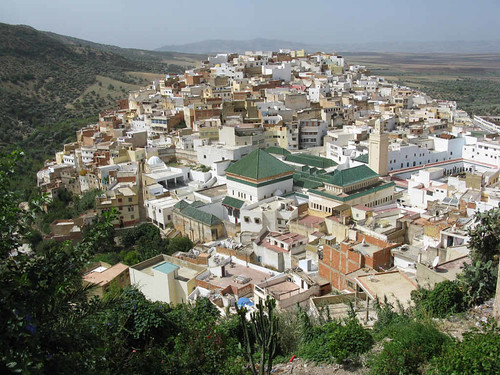The next day we had the experience of a grand taxi. There are two types of taxis in Morocco: petit taxis and grand taxis. Both are easily recognizable on the streets: the petit taxis are small and blue, the grand taxis are large and white, silver or blue. The former are like taxis we are accustomed all over the world: they carry a single passenger or party directly to the desired destination, and payment is determined by meter. The grand taxis take a car load of strangers who are going in the one general direction.
The grand taxis gather at very informal taxi ‘stations’ in several places around the cities. The taxis seem to park in no particular order; the only way to find a ride to one’s destination is by listening to the shouting of the drivers, or by walking around asking.
The grands taxis take six passengers per trip: two in front, four in back. As you can imagine, it is a bit of a squeeze to fit all these passengers in a standard 5-seat saloon car.
We endured a 35 min ride squashed in one from Meknes to Moulay Idriss.
Moulay Idriss is an important religious site and place of pilgrimage for Muslims in Morocco. The town is named after the Moroccan saint Moulay Idriss, a descendant of Muhammad, who died and was buried in 792 AD in the city that was eventually named after him. During his life in Morocco Idriss founded Morocco’s first Arab dynasty as well as the city of Fes and is accredited with converting the majority of Morocco’s population to Islam.
After shaking off the inevitable attention of the guides and taxi drivers, we headed off uphill through the steep village which is perched on a hillside. We were fascinated to find we were walking right through the middle of a local market with stalls selling everything from sweeping brushes to fruit to meat – including live hens. the butcher had several cages of live hens and a large machete on his counter. We were pleased to be ignored as we meandered here – no hard sell like at the tourist markets.
However a little later we picked up an unofficial guide. Or more truthfully he picked us up! We had wandered towards the entrance to the mosque and he got chatting to us and pointed out the way to the upper village. Then he followed us and the next thing we knew he was leading us up and up. Once we had negotiated a price we had a rather nice tour of the town with him!
Moulay Idriss’ tomb is a revered site and the town is considered to be the holiest town in Morocco. The tomb is considered to be a shrine and is accepted as a substitute pilgrimage for Muslims who cannot travel to Mecca.
Every August an important Moussem, or Muslim festival, is held in Moulay Idriss and Muslims from around the world travel to the town.
The wooden barrier is to prevent non-Muslims (and mules, which wander the streets) from entering.
Idriss Medersa, an ancient Qur’an school was built using materials taken from the nearby Roman site of Volubilis, The Idriss Medersa is famous for its unusual Minaret, added to the building by a wealthy pilgrim in 1939. The Minaret is circular, an unusual design throughout the Muslim world, and is decorated with white and green geometric shapes that spell out a passage from the Qur’an in Arabic
Our helpful guide led us back to the taxi rank and helped us negotiate a price for the next part of our journey. He may have taken us to his brother or cousin’s taxi and charged us double the rate for all we know, but it was was still cheap to us!
Our next stop was the ancient Roman archaeological site of Volubilis. This is an amazing site – even for non-historians, due to it’s large size and the fact that many of the mosaics are still pretty clear despite being exposed to the elements.
The Romans began building the city of Volubilis somewhere around 40 AD in order to keep control of this north African region which was successively occupied by the Greeks, Berbers, Jews and Carthaginian merchants. In the second and third centuries, the region began to develop more rapidly when the Romans began cultivating grain.
The Victory Arch, facing the main route was built in 217, in honour the Roman emperor Caracalla. It formerly had a bronze chariot atop its ancient stones. It was restored in 1962.
The Romans evacuated most of Morocco at the end of the 3rd century AD but, unlike some other Roman cities, Volubilis was not abandoned.People continued to live here for more than 1,000 years after this until it was abandoned in the 18th century.
Volubilis’ structures were damaged by the 1755 Lisbon earthquake, while in the 18th century part of the marble was taken for constructions in nearby Meknes.
The mosaics at Volubilis are simply amazing.
Posted in Travel Tagged: archeology, Meknes, Morocco, mosaics, Moulay Idriss, Volubilis
































